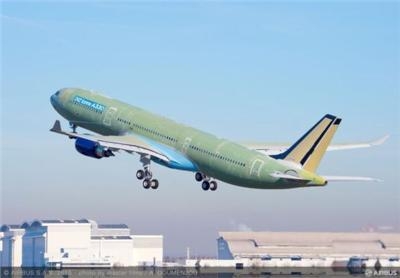Fri, Apr 03, 2015
Latest Example Of Airbus' 'Incremental Innovation' Strategy
The latest variant of the highly successful A330 – the new 242 metric ton A330-300 – has achieved certification from EASA following a 100 hour flight-test campaign. Certification from the FAA is expected soon.

Airbus said in a news release that in the near future, the smaller A330-200 model will follow the -300 by benefiting from the 242t take-off weight capability. To date 11 customers have already selected their new A330s to have a 242t capability.
“The latest A330’s maximum take-off weight capability of 242 metric tons, combined with various aerodynamic refinements and increased fuel capacity means that soon operators will benefit from an extended range of up to 500 nautical miles or carry greater payload," said Eric Zanin, Airbus’ Head of the A330 Program. "Moreover, they will do so with a fuel consumption reduction of up two percent – yet another concrete example of Airbus’ incremental innovation strategy.”
The initial certified A330-300 242t aircraft is powered by CF6-80E1 engines and certification with the other engine types – the PW4000 and Trent 700 – will follow.
The flight-test campaign of approximately 100 hours was shared between two aircraft: an Airbus test aircraft (MSN0871) which was used to validate some aerodynamic refinements, and a new production aircraft (MSN1628) whose tasks included the validation of the center tank activation and overall performance effect on the larger A330-300 platform. Notably, the 242t A330’s structure is also the basis for development of the forthcoming A330neo.
The combination of the increased take-off weight, aerodynamic improvements and the optional fuel capacity boost – compared with the previous 235t version – means that the new 242t A330-300 is capable of flying missions of up to 15 hours, or carry more payload over existing routes. In practice this means that it will allow operators to fly directly between Europe and south-East Asia and could be used for more than 90 percent of typical routes from London airports.
(Image provided by Airbus)
More News
From 2023 (YouTube Edition): "Ain’t Your Daddy’s Super Cub”—Don Wade Co-owned by Don and Ron Wade—the former of Don’s Dream Machines, a storied >[...]
Pilot-Rated Passenger Reported That The Pilot Did Not Adequately “Round Out” The Landing Flare And The Airplane Bounced And Yawed To The Right Analysis: The pilot state>[...]
Dead Reckoning Dead reckoning, as applied to flying, is the navigation of an airplane solely by means of computations based on airspeed, course, heading, wind direction, and speed,>[...]
Aero Linx: Lake Amphibian Club This website is created and sponsored by the Lake Amphibian Club, to help spread the word about these wonderful, versatile amphibians that can land j>[...]
“I am deeply honored to be sworn in as NASA administrator. NASA’s mission is as imperative and urgent as ever — to push the boundaries of human exploration, ignit>[...]
 Classic Aero-TV: In Praise of Alabamas Patriot Aircraft USA
Classic Aero-TV: In Praise of Alabamas Patriot Aircraft USA NTSB Final Report: Cirrus Design Corp SR22
NTSB Final Report: Cirrus Design Corp SR22 ANN's Daily Aero-Term (12.21.25): Dead Reckoning
ANN's Daily Aero-Term (12.21.25): Dead Reckoning ANN's Daily Aero-Linx (12.21.25)
ANN's Daily Aero-Linx (12.21.25) Aero-News: Quote of the Day (12.21.25)
Aero-News: Quote of the Day (12.21.25)



